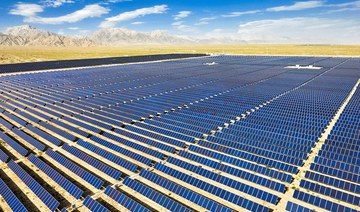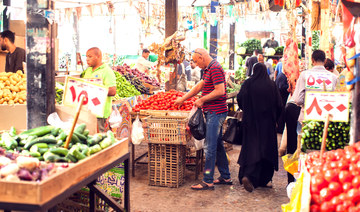RIYADH: Buoyed by the millions of Umrah performers and worshippers throughout the holy month of Ramadan, Saudi Arabia braces for a surge in travel for Eid Al-Fitr.
The spike is expected to result in a significant rise in the number of arriving and departing passengers from key Umrah airports.
Air travel between the UAE and Saudi Arabia alone has witnessed a noticeable surge, driven by increasing demand from individuals wishing to perform Umrah rituals during the holy month of Ramadan. The demand generally reaches its peak during the last 10 days of the holy month.
According to the UAE’s General Civil Aviation Authority statistics, flights between the UAE and Saudi Arabia increased by 13.3 percent in March, rising to around 383 weekly flights compared to approximately 338 in February, coinciding with the beginning of Ramadan.
Saudi aviation management firm Matarat Holding predicts that overall travelers will reach 6.6 million this year, reflecting a 25 percent growth compared to the previous year.
Khaled Al-Hamash, executive vice president of strategy at Matarat, told Arab News: “Those traveling on Umrah charter flights are 500,000 passengers and the rest are scheduled. Those traveling from and to international destinations are 4.7 million passengers and the rest are domestic.”
This comes as the Kingdom witnessed a significant influx of travelers last year. According to data released by Saudi Arabia’s General Authority of Civil Aviation in May 2023, the number of passengers to and from its airports during Ramadan and Eid Al-Fitr exceeded 11.5 million people from the beginning of the holy month until the ninth of Shawwal.
The success of last year’s hosting sets a precedent for this year’s Eid Al-Fitr celebrations, indicating the Kingdom’s readiness to facilitate travel and accommodate pilgrims during this festive period.
The impact on traveling during Eid Al-Fitr this year is anticipated to be significant, suggesting that travel demand during the season will be much higher based on previous figures.
“Eid holidays have traditionally been peak travel season for domestic and international travelers from Saudi,” Muzammil Ahussain, CEO of Almosafer, told Arab News.
He added: “This year too we have witnessed an initial upsurge in bookings for the Eid travel season. With many preferring to finalize their travel plans closer to the holidays, we are anticipating even greater demand for flights and hotel stays.”
Ahussain explained that many residents prefer shorter flights and are opting for staycation trips. This choice allows them to spend quality time with family while exploring popular tourist destinations within the country.
“Trips to AlUla and Al Ahsa are particularly attractive to domestic travelers, with top destinations like Riyadh, Dammam, and Jeddah drawing travelers,” he said.
For international trips, the CEO noted that destinations including Dubai, Cairo, and European capitals like Paris and London continue to be “all-time favorites” among travelers from Saudi Arabia.
“This year, we are also witnessing a greater demand for travel to Turkiye and Thailand, as well as far-Eastern destinations like Korea and Japan,” he added.
Capacity addition
Given the high demand during the Eid Al-Fitr period, airlines strategically adapt to accommodate the surge in passengers, both domestically and internationally.
This includes significant increases in seat capacity and flight frequency, ensuring smoother travel experiences for all passengers.
Saudia, for instance, has significantly increased the number of seats both domestically and internationally for this year’s Eid compared to the previous year’s season.
According to the Kingdom’s national carrier, the allocation of international sector seats rose by 36 percent to over 246,000 seats, with 602 flights, marking a 44 percent increase compared to Eid 2023.
Additionally, the domestic sector experienced a surge in seat capacity, with an increase of 21 percent totaling more than 270,000 seats. This was accompanied by 1,300 flights, reflecting a 21 percent increase compared to the previous year’s Eid season.
“Saudia is committed to providing a flexible operational plan throughout the year and during peak seasons. As we mark the end of Ramadan and the beginning of Eid Al-Fitr, we are seeing a high travel demand and are prepared to provide additional flights and increase seat capacity to address the growing demand,” Sulaiman Yaqoobi, chief operating officer at Saudia Group, told Arab News.
He added: “We are also sharing the spirit of Eid with Saudia’s guests onboard and at AlFursan lounges by distributing sweets and broadcasting Eid Takbeer, as we always strive to give our guests the best experience possible.”
Saudia is also capitalizing on this opportunity by offering a promotional deal, featuring a 25 percent discount for travel between Saudi Arabia, other Gulf Cooperation Council countries, and Egypt in the hospitality class.
The booking window for this offer is from April 7 to April 30, with the travel period spanning from April 9 to Sept. 30, 2024.
The Almosafer CEO highlighted that Dubai stands out as a “preferred destination” due to its proximity to Saudi Arabia and its visa-free status for Saudi passport holders, making travel there convenient, “which means people can travel with great ease.”
According to the latest data from the UAE’s GCAA, flydubai increased its flights to the Kingdom by 40 percent from 93 weekly flights in February to 130 flights in March, while Etihad Airways also increased its flights by more than 22.2 percent, from 63 flights in February to 77 flights in March.
Meanwhile, Emirates operated approximately 67 weekly flights to the Kingdom in March, covering Dammam, Jeddah, Madinah, and Riyadh, while Wizz Air Abu Dhabi operated about 21 weekly flights including Dammam and Madinah.
Additionally, flights operated by Air Arabia reached approximately 88 weekly flights, the GCAA data showed.
During Ramadan and the Umrah season, from March 11 to April 7, Etihad Airways successfully transported around 45,000 passengers to its destinations in Saudi Arabia. Most travelers visiting the Kingdom during this period were from the UAE, India, Pakistan, and Indonesia.
Surge in flights
The impact on traveling during Eid Al-Fitr is significant, with Saudi Arabia’s demonstrated ability to manage crowds and ensure the smooth operation of religious events providing reassurance to travelers.
Furthermore, the distribution of passengers across key Umrah airports offers insights into the nation’s transportation infrastructure and connectivity.
Jeddah’s King Abdulaziz International Airport emerges as the primary gateway for Umrah travelers, accommodating a staggering 81 percent of the anticipated passengers.
“Although Jeddah’s King Abdulaziz International Airport has the most traffic, Madinah’s Prince Mohammed Bin Abdulaziz International Airport follows suit, handling 16 percent of the total traffic,” Al-Hamash said.
He added: “Taif International Airport and Prince Abdul Mohsin Bin Abdulaziz International Airport in Yanbu serve as additional entry points.”
Al-Hamash also outlined the anticipated number of arriving and departing flights, both chartered and scheduled, to and from major Umrah airports during the season, spanning from the first Ramadan to the sixth of Shawwal or until after Eid Al-Fitr.
“The total expected number of flights surpasses 37,000, indicating a notable 19 percent increase compared to the previous year,” he said.
Overall, the Umrah and Eid Al-Fitr holidays are playing a key role in reviving the hospitality industry, signaling a return to the robust performance recorded across the GCC region.





















